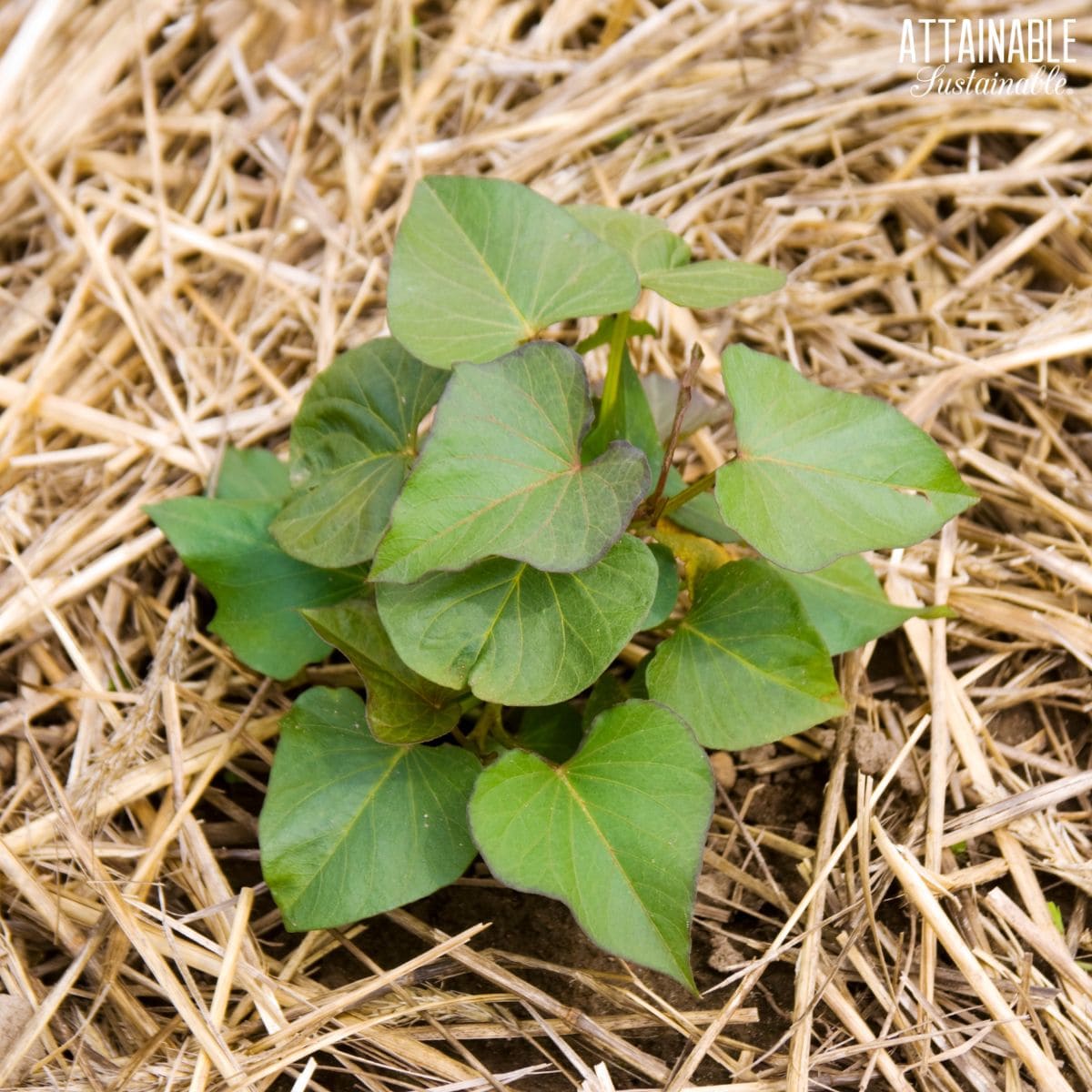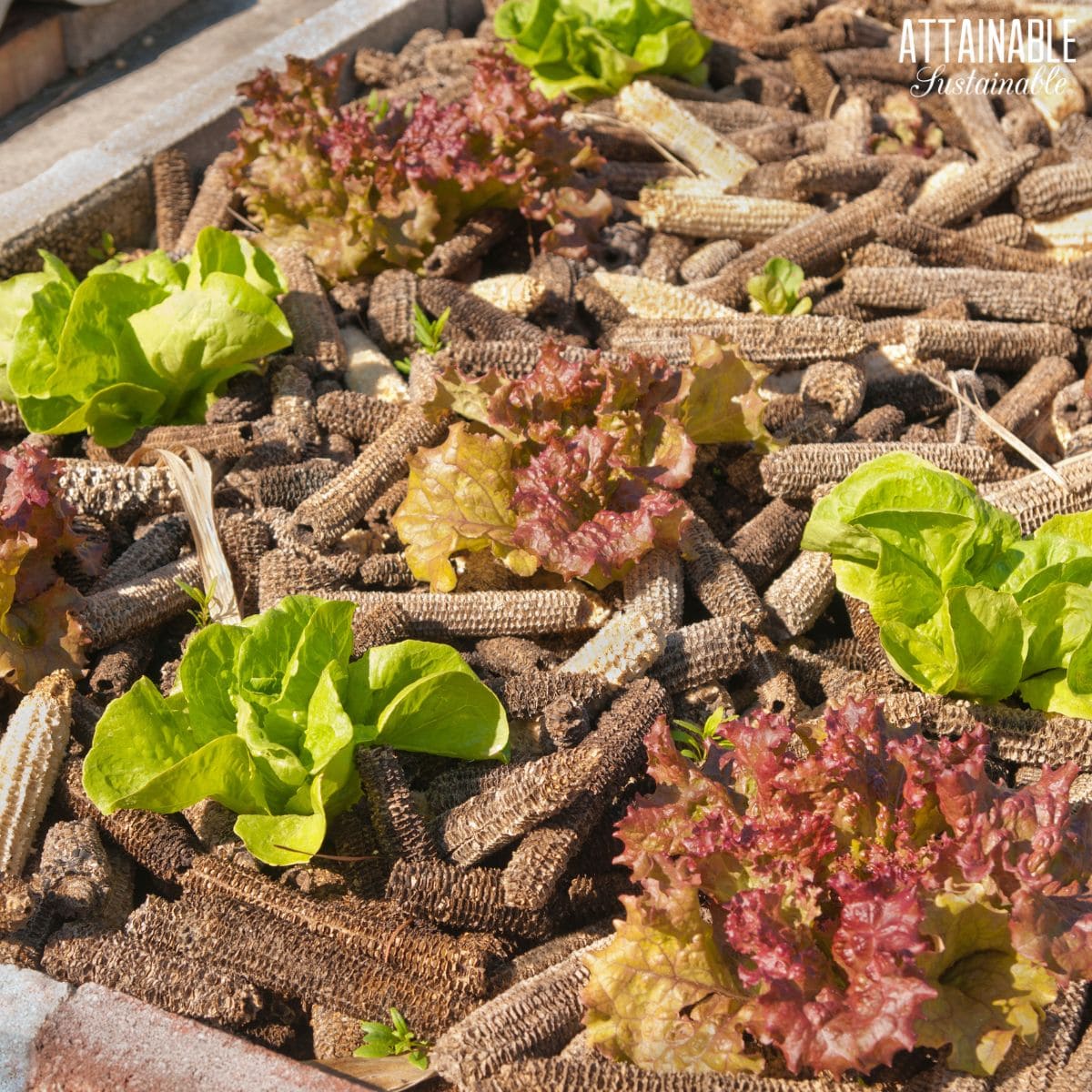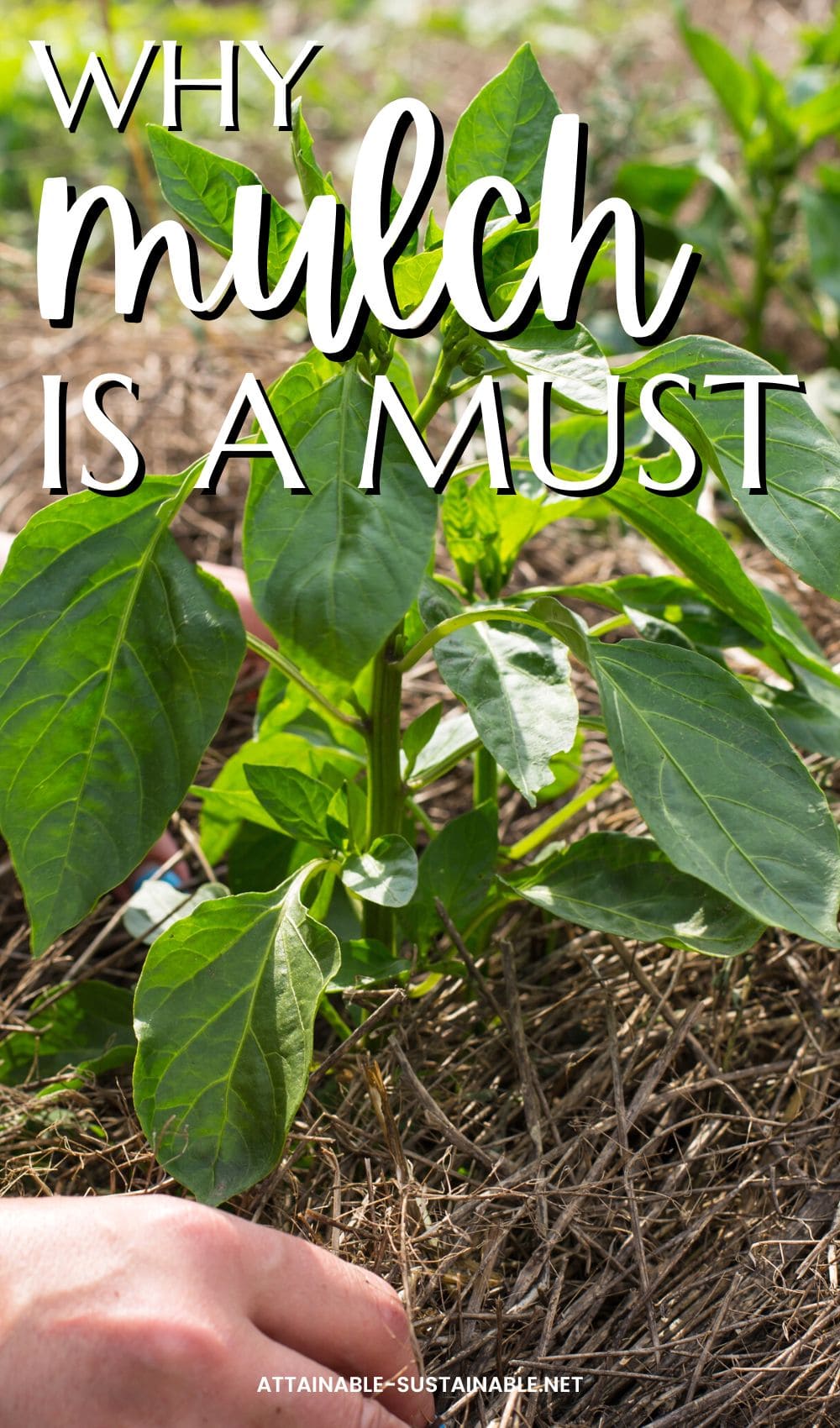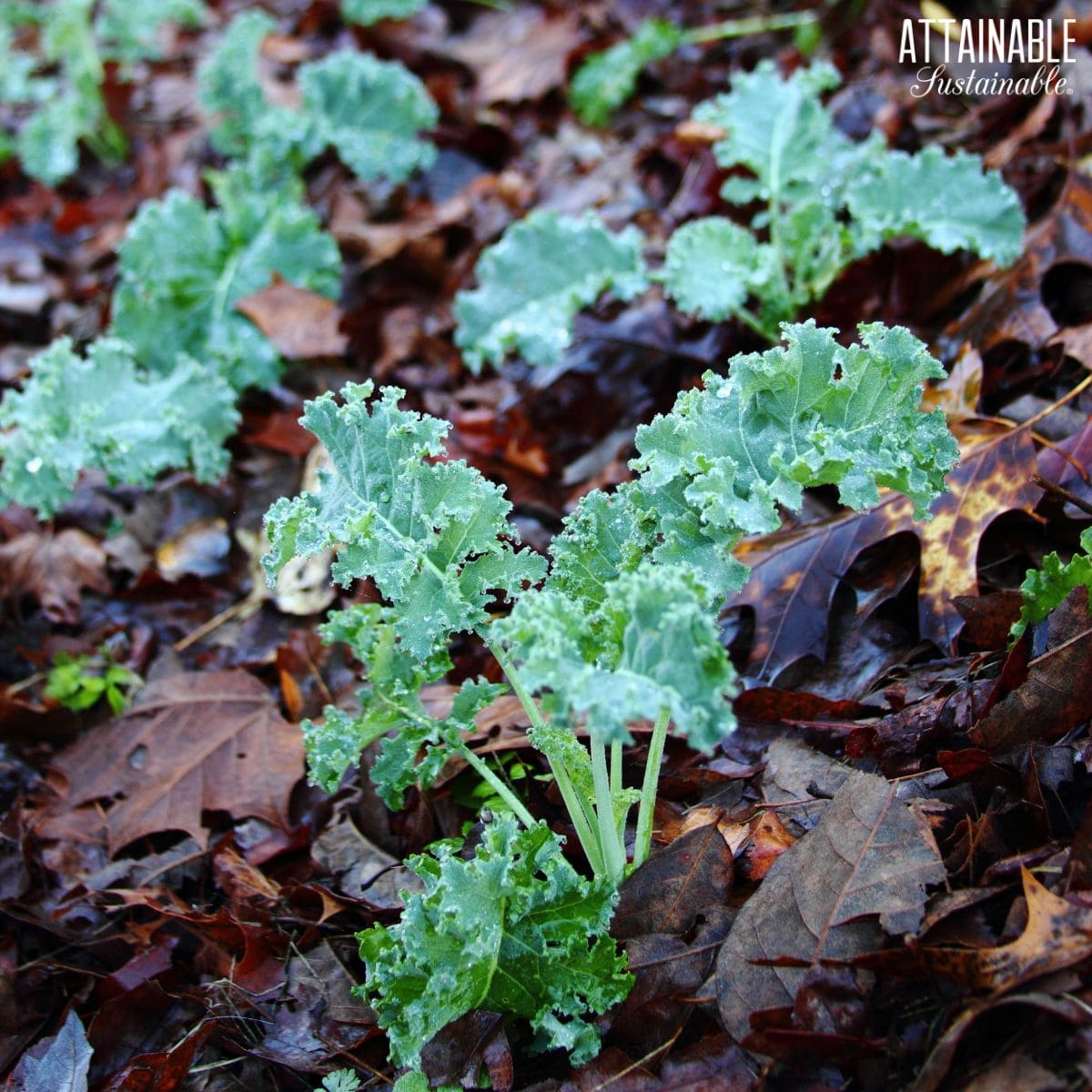While many landscapers use mulch for aesthetics, the advantage of mulching in the vegetable garden (and landscape) goes far beyond how it looks. If you haven’t yet embraced mulching, read on to learn why it’s time you did!
Originally published February 2016; this post has been updated.

New to gardening? Limited on space? The 5-Gallon Garden gives you the skills you need to grow food in the space you have. Get started with your garden today!
What is Mulch?
Mulch is a layer of material that is spread on the ground around plants. That material can vary, depending on what is readily available to you.
Dry Mulch
This type of mulch includes options that can be purchased at your local nursery, the feed store, or found in your neighborhood.
Straw: Sold by the bale, straw is an easy-to-use mulch and pretty readily available.
Bagged mulch: The texture of bagged mulch can vary from chunks of bark to a shredded bark option that we have deemed “gorilla hair.” Chunkier mulch made of bark or wood chips is best used around trees and perennial shrubs in permanent landscaping; avoid using this product on annual vegetables, herbs, flowers, or fruits.
Grow Some Greens!
Ready to grow fresh greens, no matter WHERE you live? Sign up for my
FREE quick-start guide and start growing some of your own food!
Leaves: Those bags of leaves your neighbors rake up every fall? Grab ’em. They make an excellent mulch! Pine needles are another option that work as a mulch, despite the fact that you may have heard they’d acidify the soil. They may alter the acidity a little, but really, it’s negligible. (Side note: While not commonly used in areas I’ve gardened, when I was driving along the Gulf Coast many years ago, I noticed that dry pine needles were a common mulch.)
Food processing waste: What’s available to you will vary by region, but consider nearby crop residues as a possibility. Nut shells, rice hulls, and corn stalks all make excellent mulch.
You can get creative when seeking out materials for mulching your garden. Items like dry corn cobs and pine cones might be a surprising option, but they work like any other dry mulch to improve your garden. Bonus: cats will not be able to get through this rough mulch to do their business.
Even cardboard and newspaper can act as a mulch when placed around plants, though it’s not as aesthetically pleasing as some of the other options I mentioned!
Green Mulch
This category of mulch calls for using plant material before it’s dried out, which adds moisture to the soil.
Grass clippings: Landscapers often have an abundance of lawn clippings. Be sure to use clippings from lawns that have not been treated with chemical pesticides or fertilizers. These can tend to mat and get slippery when added in a deep layer; be mindful of this in choosing this type of mulch!
Trimmings from plants: As long as they are not diseased and are free of pests – those trimmed bits can all be dropped right onto the soil.
Consider growing some mulch, too. Many plants are excellent for this purpose and provide you with an ongoing source of free mulch. I’ve compiled a list of a dozen plants here that are excellent choices if you’re interested in producing some of your own mulch on site to save money and reduce the need for “inputs” from elsewhere.
Living Mulch
The idea of a living mulch can be as simple as planting seedlings closely enough that they cover the soil. This helps to shade the soil, giving some of the benefits seen by adding a layer of mulch.
With crops that are a bit larger and longer to come to maturity, you can use quick growing crops or spreading crops to cover the ground around them. For instance, we use sweet potato as a living mulch around our taro plants and we are experimenting with planting pineapples in a thriving patch of perennial peanut grass.
These live plants shade the soil and do the work of a mulch while they are growing in the soil.
Why Use Mulch?
There are numerous reasons to add mulch to a garden, whether it’s a vegetable garden, flower garden, or a landscaped yard.
1. Retaining Moisture in the Soil
Covering bare soil with mulch reduces evaporation, allowing your plants to go longer between watering. This saves you time, it saves water, and is particularly beneficial during hot summer months when soil moisture can be wicked away in no time.
When faced with drought conditions, mulching around your veggie plants can be the difference between a healthy plant and a struggling one. (Read more techniques for gardening when water is scarce here.)
2. Weed Control
Covering the soil surface with mulch holds moisture in and it also suppresses weeds. Preventing sunlight from shining directly on the soil means weed seeds in the soil are slower to germinate. Weed seeds that fall onto mulched ground may be less likely to germinate than those that land on open soil.
If weeds do germinate, pulling them from a well-mulched garden bed is much, much easier than pulling them from the soil.
3. Regulate Soil Temperature
Maintaining a layer of mulch around your garden plants can help hold in warmth when the temperatures cool. Alternatively, as the weather heats up in the summer, that mulch can help keep the soil from overheating.
A really thick layer of mulch – 12 inches deep or more – piled around frost-tender plants can prevent them from succumbing to the winter cold, allowing you to grow perennial crops that might not otherwise survive in your region.
4. Build Nutrients
Mulch from organic materials will break down over time, adding nutrients to the soil, making it a great advantage of mulching. It’s a little like composting right on the surface of the soil. Organic mulches support the growth of beneficial soil microorganisms, fostering a healthy and balanced soil ecosystem.
Every time you add a new layer of mulch, the soil benefits.
5. Prevent Diseases
Powdery mildew in particular can be suppressed with the use of mulch. When water hits the soil, it can splash onto plants, sending powdery mildew spored onto the foliage. A layer of mulch can prevent that splashing from occurring, and thus prevent powdery mildew.
6. Prevent Soil Erosion
Exposed soil can take a beating from wind and rain. In sloped areas, it can cause soil to wash away. In areas that are not sloped, it can cause roots to become exposed. A layer of mulch protects the soil from this exposure.
7. Reduce Soil Compaction
Exposed soil tends to compact more readily than soil that’s protected with a layer of mulch. Certainly this goes for areas that are high-trafficked, but even in a raised bed, soil that’s left to face extreme weather conditions tends to compact, making it less desirable for growing.










I’m so happy to have this information as soil building for Spring 2023 begins this weekend! My garden mostly survived but definitely didn’t thrive this year so I decided to forgo winter crops and build soil instead. Honestly this is almost as exciting as planting seeds!
I’m surprised you didn’t mention cover crops.
I have winter rye and hairy vetch growing in my zone 5 garden right now.
Planted it in the fall, will cut it down (and use the rye for straw) when it’s ready.
Also used buckwheat before.
I work in a restaurant too, so I snag all the free food scrapes that I can.
I do mention chop and drop mulching which is a great method, and I also have a post on buckwheat if you’re interested. Food scraps in compost is a good method too, these all work so whatever works for you is great!